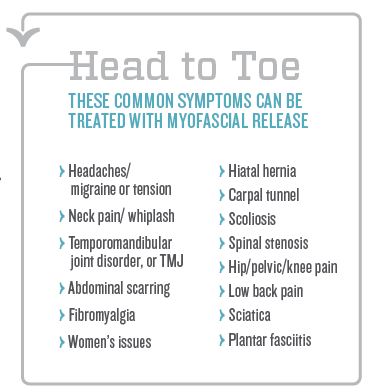Written By Derek Metzler, P.T.
Physical therapy focusing on the fibrous connective tissue could help alleviate your mysterious aches and pains
Are you in pain? Whether it is physical, mental or emotional, we have all experienced some degree of pain, which can communicate to us that something is wrong. But if pain is lingering far longer than you would expect—and X-rays, CAT scans, and MRIs aren’t giving you the answers—then perhaps you need to look under the surface of your skin for the source of your pain.
The fascia, a tough, fibrous connective tissue that attaches the skin to the body and dives deeply into a three-dimensional network, may be the answer. This network covers us from head to toe and reaches down into the cellular level. For a more visual image of how the fascia simultaneously connects and divides our body, cut open an orange and observe how the white tissue adheres the peel to the fruit, separating each individual wedge. Cut open the wedge and you will see how this same tissue creates the spaces and contains the fluid of the fruit. The fascia in our body operates much the same way, holding us together. When the fascia is healthy, it gives us a shape that is balanced and stable. Fascia has a structural integrity and resists the everyday forces placed upon the body, but is also fluid in nature, allowing us freedom of movement and flexibility.
When the fascia is unhealthy, meaning that it has become “restricted” and has lost its fluidity, it has the ability to create a variety of symptoms. Since there is no tissue or system in the body that is not intimately connected to the fascia, when restricted, it can create seemingly bizarre or “unexplainable” patterns of pain, numbness, tingling, aching, burning or other sensations. Restrictions will cause imbalances in pelvic and spinal alignment, creating increased pressures on joints, ligaments and tendons. Postural stress and strain will increase exponentially as the body is in a continuous struggle against gravity.
But how does the fascia become restricted? Restrictions in the fascial system are caused by trauma or injury, poor postural habits, repetitive activity, surgical scarring or sustained emotional holding, such as constant neck tension because of stress. As the fascial system tightens down, the fluidity is lost and can create crushing pressures on pain-sensitive structures such as nerves, blood vessels, intervertebral discs, joints, ligaments and tendons. It can feel as if your body is gluing itself down. We lose flexibility and are more prone to continual injury and re-injury.
The good news is that this can be effectively treated and reversed. A well-trained myofascial release therapist can find where the system is restricted through observation of the entire body in standing, sitting and lying positions. The therapist then uses their skilled sense of touch to locate where the fascial system is in need of release. Once the restriction is located, using their hands in contact with the skin to create gentle, but firm, pressure, the therapist maintains constant tension at the barrier of restriction. This pressure will be maintained for two to five minutes, called an essential “time element,” until the tissue releases, which usually feels like a gentle elongation. The therapist follows and releases the restrictions throughout the entire body, as most myofascial restrictions are not limited to one region, but continue in zigzag fashion along lines of tension. It is plausible that myofascial release is the missing puzzle piece for many acute and chronic symptoms that refuse to go away. The fascia is vital to healthy movement and balance in the musculoskeletal system. Treating it effectively is essential to helping many people overcome pain and symptoms preventing them from enjoying a quality of life they desire
and deserve.
—


